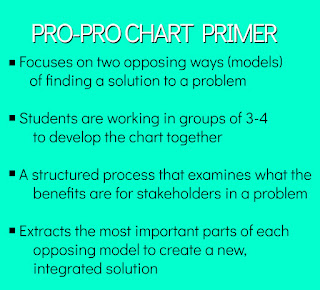What is a Pro-Pro Chart?
tool?
A group of HDSB science teachers, led by the Instructional Program Leaders for Science in both elementary and secondary panels, teaching grades 7 to 10 from eight different schools are participating in a series of workshops to learn about Integrative Thinking, which is a creative way to problem solving. It was developed by Roger Martin at Rotman School of Management as tools for businesses to make important management decisions, it quickly became apparent that these tools were enormously useful in education as a way for students to think more deeply about problems in the world around them. Rotman I-THINK tools are accessible to students in elementary and secondary and be can used to build empathy through tackling some really tricky problems and are good entry points for design thinking and project based learning.
So what are these tools? At their core, they are really well developed strategies that are structured to engage students in deep thinking, allowing them to examine the world around them. The first tool introduced by I-THINK to the Halton educators is the pro-pro chart and that is the focus of our what we’ll focus on because frankly, the tool is SO. DARN. COOL! (in a nerdy teacher pedagogical sort of way). Everyone has heard of a pro-con list for making a decision. The pro-pro chart reimagines that process to focus on the POSITIVE aspects of two opposing ideas.
In order to highlight how this tool works in the class, let’s consider a current issue that is in the media and in current political discussion, the use of cell phones by students at school, by using a pro-pro chart. For many, talking about this issue could quickly turn into examining the pros and cons list of for or against this idea. Doing so will inevitably lead to complaints, negative ideas and a process that feels like an unsatisfying answer. As the video explains, using a pro con list to make a decision results in making a decision based on the side that has the least number of cons.







Comments
Post a Comment